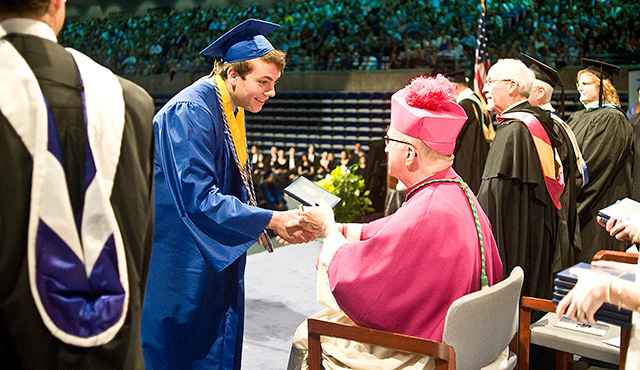Catholic schools have a rich legacy of providing students in kindergarten to high school with a quality education that encourages them to exceed academic standards while also building skills and talents in sports and the arts.
Although some public schools may provide similar opportunities at no cost, a Catholic education offers other benefits that are priceless.
“First and foremost, we teach our Catholic faith and we give students the value of a faith tradition, a tradition they can carry throughout their entire life so that as they grow older, they are able to rely upon this faith to get them through life. This also allows them to grow holistically within a Catholic faith environment,” says Sally Todd, associate superintendent of schools for the Diocese of Orange. She assists in overseeing 41 elementary and secondary schools that serve over 15,000 students.
Academically, the schools in the diocese have earned above-average test scores and have also been recognized nationally with prestigious awards. Last year, eight Diocese of Orange schools were awarded the highest U.S. Department of Education distinction through the No Child Left Behind Act-Blue Ribbon School Program. The program honors public and private K-12 schools that are academically superior in their states or demonstrate dramatic gains in student achievement.
“Based on the January 2017 Renaissance Star Test scores, our schools ranked in the 65th percentile nationally in reading, with 50th percentile being the average. We also ranked in the 73rd percentile for math, so we are academically strong,” says Todd. “What our focus is in relationship to student achievement is how students grow. We want our students who are at the 71st percentile to grow to the 72nd percentile. So no matter where the student stands in relationship to their percentile, we want to see them grow even more.”
Catholic schools also promote a school-home connection.
“We feel, rightly so, that parents are primary educators of their children,” says Todd. “We understand that we work collaboratively with parents in supporting that education.”
At St. Norbert School in Orange, Principal Joseph Ciccoianni supports this focus by working with his Parent Teacher Guild to create solutions and develop ideas. One of them is the Mentor Family Program that connects a new family to the school with a mentor family who will guide them through their first year. Eventually the families become lasting friends.
“The program has been really successful in helping new families get involved in the school. We’re finding that the families who are being mentored tend to come to PTG meetings and participate in other activities sooner than they normally would because they are invited by a friend,” says Ciccoianni.
All of the school sites have a 1-to-1 technology program, which equips each student with an iPad or Chromebook. Differentiated instruction is also very strong in the diocese. This type of instruction means that teachers meet individual student needs where they are at academically. Todd says that she believes that all students learn differently and Catholic schools provide this essential benefit.
Sts. Simon and Jude Principal Crystal Pinkofsky has taught in Catholic schools for over 30 years and has seen differentiated instruction grow and develop.
“I think we’ve come a very long way in differentiating our instruction to really help every student reach their highest potential. At our school, we have six on our faculty dedicated solely to differentiated instruction,” explains Pinkofsky. “So if we have students on the autism spectrum, they are there to support those students and give them what they need academically. Conversely if we have students, for instance, who are able to accept the challenges of geometry and advanced math and the teachers have determined these students have moved beyond algebra, then that is what we do. So that when they get to high school, they are going into advanced math courses. So, I have seen that change in Catholic education throughout the years where before we simply weren’t able to do that because we didn’t have the resources.”
Todd also credits the management style in Catholic education that benefits the growth of the students by allowing the individual schools to flourish.
“There is much more local site autonomy whereas in public schools it’s kind of the top down. Districts mandate what their schools do. In Catholic schools, it’s the opposite. Actually, our office sets the policies and serves as consultation to the schools. So the emphasis and most of the decisions in relationship to curriculum, academics or what textbooks they use are made at that local school site.”
Sports and opportunities for students to express themselves through the arts abound. Music, dance and art programs are offered through after school care and athletic programs is also a big part of the success in Catholic education.
Catholic schools in Orange County continue to set their sights higher every year as goals are met and exceeded, giving parents an option worth considering for their child.


